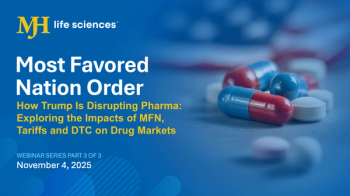
Pricing
Latest News

Latest Videos

Shorts

More News

As the federal government prepares to release newly negotiated Medicare drug prices, weight-loss blockbusters Ozempic and Wegovy remain in the spotlight, while CMS advances a model to cut Medicaid spending and broaden access to affordable treatments.

The company is launching new self-pay pricing options, expanded savings programs, and partnerships with telehealth and retail providers. all while its obesity portfolio gains momentum under the FDA’s National Priority Voucher program.

As FDA fast-tracks GLP-1 treatments under its new pilot National Priority Voucher program, WeightWatchers prepares to position itself to compete in the fast-evolving weight-loss drug market driven by affordability and accessibility.

Launching next year, the new CMS Innovation Center initiative—known as the GENEROUS Model—aims to align Medicaid drug prices with global standards, reduce prescription spending, and strengthen the program’s long-term sustainability through fairer state purchasing and transparent pricing rules.

The third entry in our premium webinar series dives into the implications the MFN order might have on wider market.

At HLTH 2025, the entrepreneur announced a collaboration between Cost Plus Drugs and President Trump’s TrumpRx platform aimed at improving transparency, reducing drug costs, and reshaping how Americans access their prescriptions.

An analysis of pricing data for 12 high-revenue drugs from Medicare Part B and Part D compares US wholesale acquisition costs with the lowest prices in reference countries under the most-favored nation model.

Amid converging pharma pricing trends, such as those triggered by the Inflation Reduction Act, companies must adopt novel operational practices and strategic approaches in line with new parameters for success across a product’s lifecycle.

Most Favored Nation drug pricing proposal aims to tie US medicine costs to lower European rates, but experts warn this approach could restrict patient access to lifesaving treatments, slow innovation, and jeopardize future drug development by importing flawed foreign price-control models.

The quest to align cost with care, enhance data visibility, and shed the dependence on outdated revenue streams.

The draft assessment finds that the popular weight loss drugs are costly but worth the price tag, while also urging for broader coverage and policy solutions.

The merger integrates EVERSANA’s commercialization services with Waltz Health’s AI-powered payer tools to address patient affordability, streamline drug access, and reduce costs for high-expense therapies such as GLP-1s.

Health plans face challenges in risk arrangements for orphan drugs, but increasing competition may open doors for innovative pricing strategies.

The 15% tariff on pharmaceutical imports from the European Union is not a short term inconvenience, it represents a structural shift in the economics of the US pharmaceutical market.

Q&A with Model N's Michael Grosberg drills deeper into the new US drug pricing directives, including challenges in implementation, the potential unintended consequences, and how these actions could spark the shift to outcomes-based contracting in healthcare.

How fragmented savings undermine transparency, patient savings, and the pharma ecosystem.

In today’s environment, aligning the Target Product Profile with the appropriate Value Evidence Archetype is not just good practice, it is a strategic imperative.

In this Pharmaceutical Executive exclusive, Bob Jansen, David Shulkin, Gen. Paul Funk (Ret.), and Maj. Gen. Dennis LeMaster (Ret.)—members of the Federated Healthcare Advisory Panel—discuss how pharmaceutical companies can strengthen supply chain resilience, navigate policy shifts, and adopt a national security mindset.

Weight-loss and diabetes drugs dominated pharmaceutical spending last year, according to a new report by the American Society of Health-System Pharmacists, who warns of tariff-driven supply chain threats and continued growth in clinic drug costs.

The argument for weighing clinical points more heavily in the access equation.

CMS’ draft guidance on real-world data study protocols marks a significant move toward transparency and rigor in Medicare coverage decisions.

“We’re going to tariff our pharmaceuticals, and once we do that, they are going to come rushing back into our country," President Donald J. Trump said during a Tuesday night dinner in Washington.

Eli Lilly CEO David Ricks to the BBC: “It feels like it'll be hard to come back from here."

Demonstrating clinical benefit is the ultimate gateway to smoother patient access.

With the Inflation Reduction Act now in flux, how will the government and industry respond?














